 |
 |
|
 |
|
 |
|  |
|  |
|
 |
|
 |
|  |
|  |
|
 |
Can you do blurred transmission too?
_____________
Kari Kivisalo
Post a reply to this message
|
 |
|  |
|  |
|
 |
|
 |
|  |
|  |
|
 |
Do you mean like this?
-tgq
"Kari Kivisalo" <ray### [at] engineer com> wrote in message
news:3BCD892B.2AAF86F8@engineer.com...
>
> Can you do blurred transmission too?
>
> _____________
> Kari Kivisalo com> wrote in message
news:3BCD892B.2AAF86F8@engineer.com...
>
> Can you do blurred transmission too?
>
> _____________
> Kari Kivisalo
Post a reply to this message
Attachments:
Download 'Sheet.jpg' (66 KB)
Preview of image 'Sheet.jpg'
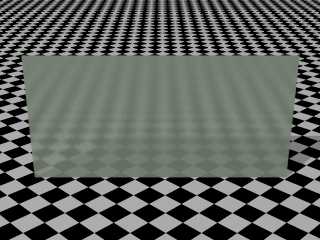
|
 |
|  |
|  |
|
 |
|
 |
|  |
|  |
|
 |
Trevor Quayle wrote:
>
> Do you mean like this?
Yes. Another key step towards realism :) I had plans to try
this with multiple averaged bumps at different base frequencies
but never got around calculating the required contributions
and scale factors.
_____________
Kari Kivisalo
Post a reply to this message
|
 |
|  |
|  |
|
 |
|
 |
|  |
|  |
|
 |
On Wed, 17 Oct 2001 18:42:19 +0300, Kari Kivisalo wrote:
>Trevor Quayle wrote:
>>
>> Do you mean like this?
>
>Yes. Another key step towards realism :) I had plans to try
>this with multiple averaged bumps at different base frequencies
>but never got around calculating the required contributions
>and scale factors.
Besides blurred transmission, there's another cool benefit to this method:
anisotropic blurring.
The first picture has no blurring.
The second picture has isotropic blurring.
The third picture has anisotropic blurring; the bumps are much taller than
they are wide. In a way, the cylinder has lots of vertical microscratches.
Post a reply to this message
Attachments:
Download 'blur-none.jpg' (51 KB)
Download 'blur-isotropic.jpg' (33 KB)
Download 'blur-anisotropic.jpg' (38 KB)
Preview of image 'blur-none.jpg'
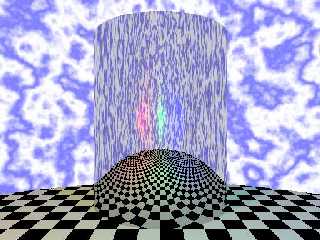
Preview of image 'blur-isotropic.jpg'
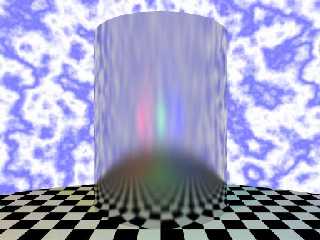
Preview of image 'blur-anisotropic.jpg'
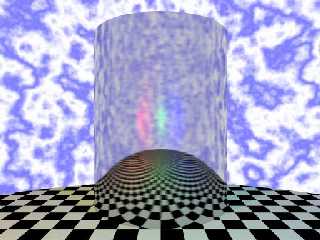
|
 |
|  |
|  |
|
 |
|
 |
|  |
|  |
|
 |
Ron Parker wrote:
>
> anisotropic blurring.
Didn't someone ask about brushed/machined metal textures?
Let's see some :)
_____________
Kari Kivisalo
Post a reply to this message
|
 |
|  |
|  |
|
 |
|
 |
|  |
|  |
|
 |
On Wed, 17 Oct 2001 21:30:23 +0300, Kari Kivisalo wrote:
>Ron Parker wrote:
>>
>> anisotropic blurring.
>
>Didn't someone ask about brushed/machined metal textures?
>Let's see some :)
Well, the downside of this is that it requires antialiasing for the whole
scene. In my case, I rendered with +a0.0 +am2 +r5, which takes forever
even for that size image even on an Athlon 1.4GHz.
--
#macro R(P)z+_(P)_(P)_(P+1)_(P+1)+z#end#macro Q(C)bicubic_patch{type 1u_steps 6
v_steps 6R(1)R(3)R(5)R(7)translate 9*z-2pigment{rgb z}}#end#macro _(Y)#local X=
asc(substr(C,Y,1))-65;<mod(X,4)div(X,4)>#end#local O=union{Q("ABEFUQWS")Q(// RON
"WSXTLOJN")}Q("JNKLCGCD")union{O}union{O translate 3*x}light_source{x 1}//PARKER
Post a reply to this message
|
 |
|  |
|  |
|
 |
|
 |
|  |
|  |
|
 |
"Ron Parker" <ron### [at] povray org> ha scritto nel messaggio
news:slr### [at] fwi org> ha scritto nel messaggio
news:slr### [at] fwi com...
> On Wed, 17 Oct 2001 21:30:23 +0300, Kari Kivisalo wrote:
> >Ron Parker wrote:
> >>
> >> anisotropic blurring.
> >
> >Didn't someone ask about brushed/machined metal textures?
> >Let's see some :)
>
> Well, the downside of this is that it requires antialiasing for the whole
> scene. In my case, I rendered with +a0.0 +am2 +r5, which takes forever
> even for that size image even on an Athlon 1.4GHz.
...which too bad does not make it likely to be used in *real* scenes :-( com...
> On Wed, 17 Oct 2001 21:30:23 +0300, Kari Kivisalo wrote:
> >Ron Parker wrote:
> >>
> >> anisotropic blurring.
> >
> >Didn't someone ask about brushed/machined metal textures?
> >Let's see some :)
>
> Well, the downside of this is that it requires antialiasing for the whole
> scene. In my case, I rendered with +a0.0 +am2 +r5, which takes forever
> even for that size image even on an Athlon 1.4GHz.
...which too bad does not make it likely to be used in *real* scenes :-(
Post a reply to this message
|
 |
|  |
|  |
|
 |
|
 |
|  |
|  |
|
 |
On Wed, 17 Oct 2001 20:34:36 +0200, JRG wrote:
>"Ron Parker" <ron### [at] povray org> ha scritto nel messaggio
>news:slr### [at] fwi org> ha scritto nel messaggio
>news:slr### [at] fwi com...
>> On Wed, 17 Oct 2001 21:30:23 +0300, Kari Kivisalo wrote:
>> >Ron Parker wrote:
>> >>
>> >> anisotropic blurring.
>> >
>> >Didn't someone ask about brushed/machined metal textures?
>> >Let's see some :)
>>
>> Well, the downside of this is that it requires antialiasing for the whole
>> scene. In my case, I rendered with +a0.0 +am2 +r5, which takes forever
>> even for that size image even on an Athlon 1.4GHz.
>
>...which too bad does not make it likely to be used in *real* scenes :-(
Here's another one, with slightly less blurring because I rendered it on
my P200 rather than my Athlon. It's notable for the jaggy lines in the
checkerboard floor...
Rendered with a development build of 3.5, but with a custom patch. Whether
that patch makes it into 3.5 or into the next MegaPOV is something I need to
discuss with some people. Render time was 4:32, which isn't bad for a P200.
The cylinder was supersampled 25 times per ray (vs. 1089 for the images I
posted before.)
So what's so special about this patch compared to the old reflection blur?
Well, let's just say it's not limited to reflection, shall we? com...
>> On Wed, 17 Oct 2001 21:30:23 +0300, Kari Kivisalo wrote:
>> >Ron Parker wrote:
>> >>
>> >> anisotropic blurring.
>> >
>> >Didn't someone ask about brushed/machined metal textures?
>> >Let's see some :)
>>
>> Well, the downside of this is that it requires antialiasing for the whole
>> scene. In my case, I rendered with +a0.0 +am2 +r5, which takes forever
>> even for that size image even on an Athlon 1.4GHz.
>
>...which too bad does not make it likely to be used in *real* scenes :-(
Here's another one, with slightly less blurring because I rendered it on
my P200 rather than my Athlon. It's notable for the jaggy lines in the
checkerboard floor...
Rendered with a development build of 3.5, but with a custom patch. Whether
that patch makes it into 3.5 or into the next MegaPOV is something I need to
discuss with some people. Render time was 4:32, which isn't bad for a P200.
The cylinder was supersampled 25 times per ray (vs. 1089 for the images I
posted before.)
So what's so special about this patch compared to the old reflection blur?
Well, let's just say it's not limited to reflection, shall we?
Post a reply to this message
Attachments:
Download 'jb.jpg' (20 KB)
Preview of image 'jb.jpg'
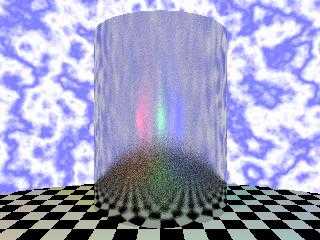
|
 |
|  |
|  |
|
 |
|
 |
|  |
|  |
|
 |
"Ron Parker" <ron### [at] povray org> ha scritto nel messaggio
news:slr### [at] fwi org> ha scritto nel messaggio
news:slr### [at] fwi com...
> On Wed, 17 Oct 2001 20:34:36 +0200, JRG wrote:
> >"Ron Parker" <ron### [at] povray com...
> On Wed, 17 Oct 2001 20:34:36 +0200, JRG wrote:
> >"Ron Parker" <ron### [at] povray org> ha scritto nel messaggio
> >news:slr### [at] fwi org> ha scritto nel messaggio
> >news:slr### [at] fwi com...
> >> On Wed, 17 Oct 2001 21:30:23 +0300, Kari Kivisalo wrote:
> >> >Ron Parker wrote:
> >> >>
> >> >> anisotropic blurring.
> >> >
> >> >Didn't someone ask about brushed/machined metal textures?
> >> >Let's see some :)
> >>
> >> Well, the downside of this is that it requires antialiasing for the
whole
> >> scene. In my case, I rendered with +a0.0 +am2 +r5, which takes forever
> >> even for that size image even on an Athlon 1.4GHz.
> >
> >...which too bad does not make it likely to be used in *real* scenes :-(
>
> Here's another one, with slightly less blurring because I rendered it on
> my P200 rather than my Athlon. It's notable for the jaggy lines in the
> checkerboard floor...
>
> Rendered with a development build of 3.5, but with a custom patch.
Whether
> that patch makes it into 3.5 or into the next MegaPOV is something I need
to
> discuss with some people. Render time was 4:32, which isn't bad for a
P200.
> The cylinder was supersampled 25 times per ray (vs. 1089 for the images I
> posted before.)
>
> So what's so special about this patch compared to the old reflection blur?
> Well, let's just say it's not limited to reflection, shall we?
*droooooooling* :-|_
(something like stochastic raytracing?)
--
Jonathan. com...
> >> On Wed, 17 Oct 2001 21:30:23 +0300, Kari Kivisalo wrote:
> >> >Ron Parker wrote:
> >> >>
> >> >> anisotropic blurring.
> >> >
> >> >Didn't someone ask about brushed/machined metal textures?
> >> >Let's see some :)
> >>
> >> Well, the downside of this is that it requires antialiasing for the
whole
> >> scene. In my case, I rendered with +a0.0 +am2 +r5, which takes forever
> >> even for that size image even on an Athlon 1.4GHz.
> >
> >...which too bad does not make it likely to be used in *real* scenes :-(
>
> Here's another one, with slightly less blurring because I rendered it on
> my P200 rather than my Athlon. It's notable for the jaggy lines in the
> checkerboard floor...
>
> Rendered with a development build of 3.5, but with a custom patch.
Whether
> that patch makes it into 3.5 or into the next MegaPOV is something I need
to
> discuss with some people. Render time was 4:32, which isn't bad for a
P200.
> The cylinder was supersampled 25 times per ray (vs. 1089 for the images I
> posted before.)
>
> So what's so special about this patch compared to the old reflection blur?
> Well, let's just say it's not limited to reflection, shall we?
*droooooooling* :-|_
(something like stochastic raytracing?)
--
Jonathan.
Post a reply to this message
|
 |
|  |
|  |
|
 |
|
 |
|  |
|  |
|
 |
On Wed, 17 Oct 2001 22:43:44 +0200, JRG wrote:
>> So what's so special about this patch compared to the old reflection blur?
>> Well, let's just say it's not limited to reflection, shall we?
>
>(something like stochastic raytracing?)
Sort of. I've added a "supersample n,d" statement to the finish statement,
which causes POV to evaluate the texture n times while jittering the normal's
evaluation point within d of the actual evaluation point. That means that,
if you have the CPU horsepower, you can do blurred isotropic reflection as
with the old patch, but also blurred anisotropic reflection, both kinds of
transmission, and maybe even real specular highlights, just by adding a
very small-scale normal to the surface.
I, of course, don't have that kind of horsepower. But here's a sample of
blurred transmission that was within reach of my limited CPU. The stats
are included for the curious:
Done Tracing
Statistics for blur.pov, Resolution 320 x 240
----------------------------------------------------------------------------
Pixels: 76800 Samples: 76800 Smpls/Pxl: 1.00
Rays: 1395150 Saved: 0 Max Level: 3/5
----------------------------------------------------------------------------
Ray->Shape Intersection Tests Succeeded Percentage
----------------------------------------------------------------------------
Box 2726599 1054773 38.68
Cone/Cylinder 10906396 22138 0.20
Plane 5453198 2035619 37.33
Sphere 2726599 2726599 100.00
----------------------------------------------------------------------------
Calls to Noise: 5679714 Calls to DNoise: 6998074
----------------------------------------------------------------------------
Shadow Ray Tests: 10651592 Succeeded: 794019
Refracted Rays: 1318350
----------------------------------------------------------------------------
Smallest Alloc: 16 bytes Largest: 12040
Peak memory used: 94390 bytes
----------------------------------------------------------------------------
Time For Trace: 0 hours 7 minutes 26.0 seconds (446 seconds)
Total Time: 0 hours 7 minutes 26.0 seconds (446 seconds)
Post a reply to this message
Attachments:
Download 'blur3.jpg' (21 KB)
Preview of image 'blur3.jpg'
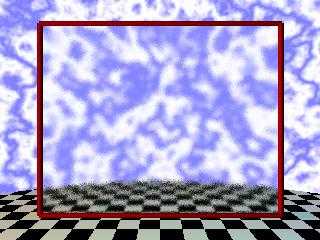
|
 |
|  |
|  |
|
 |
|
 |
|  |




![]()